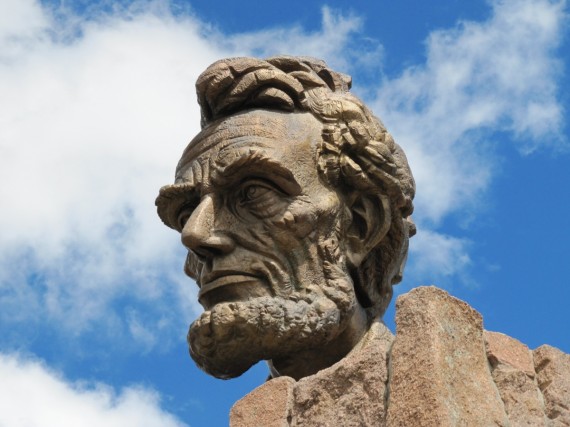On my way east on I-80 last week, between Cheyenne and Laramie, I came across the Wyoming Abraham Lincoln Monument. It originally stood at Sherman Summit, 8,878 feet above sea level, the highest point along the old coast-to-coast Lincoln Highway. When I-80 was completed in 1969, the head was moved to its current location, about 195 feet lower but seen by many more travelers.
The monument was created in 1959 by Wyoming State Parks Commission and the sculptor Robert I. Russin, a University of Wyoming art professor, to honor the sesquicentennial of Lincoln’s birth. The bronze bust of Lincoln’s head is 13.5 feet tall. Russin required ten tons of clay and eleven months of work to create the head.
The original casting was done in Mexico City and the sculpture is comprised of thirty pieces that were bolted together. The bust, weighing two tons, sits on a thirty-five-foot tall granite pedestal. The base is hollow and when Russin died in 2007, his ashes were interred inside.
The Monument is a reminder of Lincoln’s Second Annual Message to the Senate and House of Representatives on December 1, 1862 wherein he detailed his plan for the remunerative emancipation of slaves:
It is not “Can any of us imagine better?” but “Can we all do better?” Object whatsoever is possible, still the question recurs, “Can we do better?” The dogmas of the quiet past are inadequate to the stormy present. The occasion is piled high with difficulty, and we must rise with the occasion. As our case is new, so we must think anew and act anew. We must disenthrall ourselves, and then we shall save our country. (Abraham Lincoln, Second Annual Message, emphasis added.)




Indeed, during the nation’s darkest hour, Abraham Lincoln was able to ride above the storms of his life and lead as President. While he was never able to achieve complete emancipation from his psychological problems like the freedom that was won for the Negro slaves, Abraham Lincoln heroically faced the obstacles and hardships to become America’s most revered president.